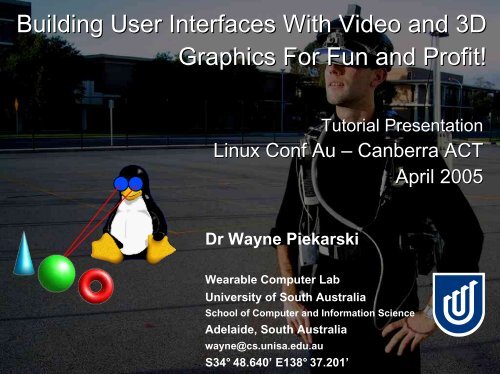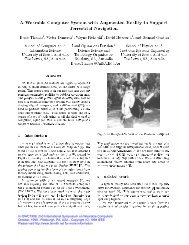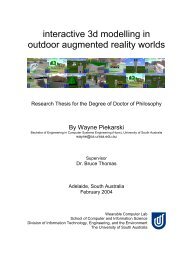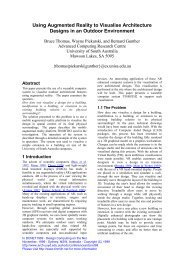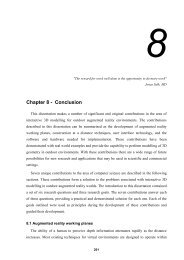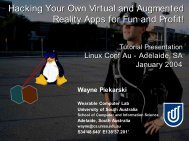piekarski-slides-lca.. - Tinmith Augmented Reality Project
piekarski-slides-lca.. - Tinmith Augmented Reality Project
piekarski-slides-lca.. - Tinmith Augmented Reality Project
- No tags were found...
Create successful ePaper yourself
Turn your PDF publications into a flip-book with our unique Google optimized e-Paper software.
Building User Interfaces With Video and 3DGraphics For Fun and Profit!Tutorial PresentationLinux Conf Au – Canberra ACTApril 2005Dr Wayne PiekarskiWearable Computer LabUniversity of South AustraliaSchool of Computer and Information ScienceAdelaide, South Australiawayne@cs.unisa.edu.auS34° 48.640’ E138° 37.201’1 Wayne Piekarski Wearable Computer Lab CIS @ UniSA http://www.tinmith.net/<strong>lca</strong>2005<strong>lca</strong> 2005
What is this tutorial about?• Brief introduction to 3D, virtual and augmented reality• OpenGL and live video display under X11• Video capture using Video4Linux and Firewire• 3D vision tracking using ARToolKit and OpenCV• Custom hardware input devices• Demos of <strong>Tinmith</strong> backpack• Show you the kinds of cool applications you can build athome without having to spend a lot of money!2 Wayne Piekarski Wearable Computer Lab CIS @ UniSA http://www.tinmith.net/<strong>lca</strong>2005<strong>lca</strong> 2005
What is this tutorial not about?• Will not repeat what you can easily learn elsewhere• Linux distro installs, basic OpenGL, simple C programming• I will assume you know something about these• Mainly focusing on Linux specific problems and solutions• Lots of things which are not documented very well• This talk is totally different from my 2000-2003 LCA talks!3 Wayne Piekarski Wearable Computer Lab CIS @ UniSA http://www.tinmith.net/<strong>lca</strong>2005<strong>lca</strong> 2005
Tutorial and supplied materials• 3 hour presentation with a break half way• 1.5h talking, 0.5h break, 1.5h talking• Question times at the end of each section• 45 pages of notes with extra material and code snippets• This presentation will be more higher level than the notes• Will talk about things at a different angle than the notes• CD contains example demos and scripts• Also includes open source programs and libraries• http://www.tinmith.net/<strong>lca</strong>2005• During LCA we will take the backpack outside• Inspection of internals, as well as demos4 Wayne Piekarski Wearable Computer Lab CIS @ UniSA http://www.tinmith.net/<strong>lca</strong>2005<strong>lca</strong> 2005
Lazy like a fox• Teach you interesting things you can do at home to hackaround with 3D right now!• Lots of projects, not enough time to work on them• Focus is on areas that are poorly documented or difficultto play around with due to complexity• Tricks to build things on the cheap• http://www.tinmith.net/<strong>lca</strong>20055 Wayne Piekarski Wearable Computer Lab CIS @ UniSA http://www.tinmith.net/<strong>lca</strong>2005<strong>lca</strong> 2005
Intro to immersive 3D graphics6<strong>lca</strong> 2005
Immersive 3D graphics• My research work focuses on immersive 3D applications• I typically use a head mounted display• There are plenty of things we can do on a monitor though!7 Wayne Piekarski Wearable Computer Lab CIS @ UniSA http://www.tinmith.net/<strong>lca</strong>2005<strong>lca</strong> 2005
Virtual and augmented reality• Virtual reality is purely computer generated graphics• <strong>Augmented</strong> reality combines the physical world withartificial computer graphics8 Wayne Piekarski Wearable Computer Lab CIS @ UniSA http://www.tinmith.net/<strong>lca</strong>2005<strong>lca</strong> 2005
Optical augmented reality• Hard to find these displays for a reasonable price nowGeneratedGraphicsComputerPhysical WorldDisplayVirtual WorldOpticalCombinerFinal View9 Wayne Piekarski Wearable Computer Lab CIS @ UniSA http://www.tinmith.net/<strong>lca</strong>2005<strong>lca</strong> 2005
Video augmented reality• Displays from VR can be used with no modifications• We use these displays almost exclusively now• Cheaper and easier to buy, better quality outputComputerVirtual WorldGeneratedGraphicsFinal ViewCameraDisplayPhysical World10 Wayne Piekarski Wearable Computer Lab CIS @ UniSA http://www.tinmith.net/<strong>lca</strong>2005<strong>lca</strong> 2005
Outdoor augmented reality• My research work focuses on performing AR outdoors• Especially mobile 3D user interfaces and modelling11 Wayne Piekarski Wearable Computer Lab CIS @ UniSA http://www.tinmith.net/<strong>lca</strong>2005<strong>lca</strong> 2005
3D compared to 2D• 3D is much more challenging than 2D• More degrees of freedom and more input devices• More realistic and intuitive application possibilities• Potential to use the body directly• Don’t use 2D input devicesto solve a 3D task!12 Wayne Piekarski Wearable Computer Lab CIS @ UniSA http://www.tinmith.net/<strong>lca</strong>2005<strong>lca</strong> 2005
<strong>Tinmith</strong> mobile 3D modelling• Gloves are used to control the environment• User interface designed specifically for mobile AR• Supports outdoor modelling and editing applications13 Wayne Piekarski Wearable Computer Lab CIS @ UniSA http://www.tinmith.net/<strong>lca</strong>2005<strong>lca</strong> 2005
• Play UI demo video hereUser interface demonstration14 Wayne Piekarski Wearable Computer Lab CIS @ UniSA http://www.tinmith.net/<strong>lca</strong>2005<strong>lca</strong> 2005
ARQuake demonstration• Play demo video here15 Wayne Piekarski Wearable Computer Lab CIS @ UniSA http://www.tinmith.net/<strong>lca</strong>2005<strong>lca</strong> 2005
Tracking• To generate a view, the computer needs to know theposition and orientation of the user’s head• May also require tracking of body parts and tools• Restricts the types of user interfaces we can use!• Accel/gyro/magnetic InertiaCube2• A$2500• Trimble Ag132 GPS• A$6500• ARToolKit vision tracking• Cost of video camera = $Cheap• Magnetic, optical, ultrasonic, mechanical16 Wayne Piekarski Wearable Computer Lab CIS @ UniSA http://www.tinmith.net/<strong>lca</strong>2005<strong>lca</strong> 2005
Processing• We need to carry sufficient computing power with us• 3D graphics requires fast video chipset• Video processing and capture can be CPU intensive• Most small computers have stripped down graphicshardware because the demand for this is low• Laptops used to be pretty poor as well• Games market spawned powerful laptops with 3D GPUs• Getting laptops with good 3D and small sizes and goodpower consumption is still a problem though17 Wayne Piekarski Wearable Computer Lab CIS @ UniSA http://www.tinmith.net/<strong>lca</strong>2005<strong>lca</strong> 2005
• Not everyone has a backpack like meIndoor AR/VR• Indoor setups for VR and AR• Still require expensive tracking hardware and HMD• Slightly easier because hardware can be bulky• Limited operating area18 Wayne Piekarski Wearable Computer Lab CIS @ UniSA http://www.tinmith.net/<strong>lca</strong>2005<strong>lca</strong> 2005
Free beer AR• AR and VR are dominated by the cost of the hardware• But free beer and free speech are also possible in AR!• ARToolKit• Hirokazu Kato and Mark Billinghurst• University of Washington• More on this later• Show live demo19 Wayne Piekarski Wearable Computer Lab CIS @ UniSA http://www.tinmith.net/<strong>lca</strong>2005<strong>lca</strong> 2005
Distribution installation21<strong>lca</strong> 2005
Distribution installation• I currently use Debian as my platform of choice• Comes with lots of packages, some of which are obscure• You cannot use stable for this tutorial, it is way too old!• Testing and unstable keep breaking all the time, but it isfine if you are willing to fix up these problems• Debian also isn't all that friendly for obvious things• Still looking for an ideal distribution• Knoppix breaks after a few months, Ubuntu lookspromising with its 6 month stable cycles• I can’t afford to spend weeks configuring a machine• Simple things should be simple, complex to be possible22 Wayne Piekarski Wearable Computer Lab CIS @ UniSA http://www.tinmith.net/<strong>lca</strong>2005<strong>lca</strong> 2005
Software requirements• Does not matter what distribution you use• To be on the safe side, install as much as you can so youcan avoid chasing up missing packages• Make sure you include (see notes)• Devel, XFree86, DRI, OpenGL, Kernel, Firewire• I have prepared a set of Debian dependency packages• Add http://www.tinmith.net/debian ./ to your sources.list• Install tinmith-devel and tinmith-desktop and this will add allthe dependencies that you will need• I have gone to all the trouble to make installs easy for all23 Wayne Piekarski Wearable Computer Lab CIS @ UniSA http://www.tinmith.net/<strong>lca</strong>2005<strong>lca</strong> 2005
3D graphics infrastructure24<strong>lca</strong> 2005
Graphics libraries• Xlib• Existing X11 drawing library used for all X applications• GLX• Extension to X11 to allow OpenGL over X connection• DRI• Direct rendering interface for XFree86• GL• Core drawing functionality, possibly accelerated• GLU• Utility library, simplifies some GL calls for the programmer• GLUT• Utility toolkit provides a portable programming interface25 Wayne Piekarski Wearable Computer Lab CIS @ UniSA http://www.tinmith.net/<strong>lca</strong>2005<strong>lca</strong> 2005
OpenGL advantages• Previously, required both X server and client processes• For intensive drawing you waste a lot of CPU time• X protocol and memory usage• Kernel read() and write() calls• Task switching• X is not very good at massive primitive numbers• This is why SGI implemented direct rendering• Now we have GLX and DRI in XFree86 based on this• Server sets up video card for security• Client can then run without any intervention• System calls are evil, we can avoid them now!26 Wayne Piekarski Wearable Computer Lab CIS @ UniSA http://www.tinmith.net/<strong>lca</strong>2005<strong>lca</strong> 2005
3D hardware is cheap• Nowadays 3D hardware is available in almost all PCs• Old cards are still excellent, get them for free from peoplethrowing them away!• Older cards have more mature drivers as well• 3D drivers are very complicated monsters!• Most cards do not use hardware for all OpenGL calls,only the most commonly used calls• SGI used to implement full hardware support though27 Wayne Piekarski Wearable Computer Lab CIS @ UniSA http://www.tinmith.net/<strong>lca</strong>2005<strong>lca</strong> 2005
Nvidia and ATI• Nvidia provide well supported closed source binaries• TNT2 is reasonable, GeForce2 is minimum recommended• Used this extensively on many boxes with good results• Same code base as Windows so has good performance• Excellent reliability (watch out for some 2.6.x kernels)• DRI provide open source driver for ATI cards up to 9200• Works ok but still has lots of bugs in it on my 9000 laptop• DRI does not support any cards past Radeon 9200• ATI provide binary drivers but they are not well supported• I will chose Nvidia any day, Radeons are not as good28 Wayne Piekarski Wearable Computer Lab CIS @ UniSA http://www.tinmith.net/<strong>lca</strong>2005<strong>lca</strong> 2005
Nvidia and ATI• Avoid other hardware if you can• Integrated chipsets are much slower• Nvidia and ATI are the two big players• Drivers tend to be not as good for less mainstream gear• Only people with laptops should not be using ATI/Nvidia• Nvidia versus ATI always starts religious flame wars• Nvidia do not release specifications for their cards, but theydo provide good quality drivers that work• I need to use hardware that works and is reliable, there isno point using software that causes trouble if it can beavoided29 Wayne Piekarski Wearable Computer Lab CIS @ UniSA http://www.tinmith.net/<strong>lca</strong>2005<strong>lca</strong> 2005
Learning OpenGL• OpenGL Red Book is what everyone learns from• Available online for free as a PDF, also lots of tutorials• OpenGL is beautifully designed and super easy to learn• It is not convoluted and tricky like Xlib• Simple things are simple• Optimisation and tricky things are still possible• Supports primitive rendering, shading, textures, depthbuffering, 2D and 3D projections, linear transformations,and display lists• Everything you need to write both 2D and 3D applications• X supports 2D primitives and windowing, that’s about it30 Wayne Piekarski Wearable Computer Lab CIS @ UniSA http://www.tinmith.net/<strong>lca</strong>2005<strong>lca</strong> 2005
Using OpenGL• I write most of my apps using pure OpenGL now• I use X only as a way of opening a window for OpenGL• No way under X to draw lots of primitives withoutincurring the overheads described before• If you use X then you get hardware acceleration but youare limited by client/server overheads• If you draw locally you can use SHM and DGA to copydirect to hardware but you have no primitive acceleration• I’ve always wanted an Xlib which was compiled directlyinto the client or allowed direct access to the hardware• We now have it in the form of DRI31 Wayne Piekarski Wearable Computer Lab CIS @ UniSA http://www.tinmith.net/<strong>lca</strong>2005<strong>lca</strong> 2005
Catches of OpenGL• Pipelined in video card to maximise performance• May introduce some latency, not sure how much• Doesn’t seem to cause a problem for live video though• OpenGL is just a renderer, whereas X has toolkits on topof it like Qt and GTK• Some toolkits have been ported to OpenGL recently though32 Wayne Piekarski Wearable Computer Lab CIS @ UniSA http://www.tinmith.net/<strong>lca</strong>2005<strong>lca</strong> 2005
Useful example• X has trouble displaying live video• MIT SHM, Xvideo, DGA, etc• Each driver in XFree86 supports some but not others• You have to write your client to support all of them!• X doesn’t expose the entire acceleration of the video card• OpenGL can display texture maps natively• Not just render but perform warping, scaling, etc• Can render to flat 2D or any 3D polygon!• OpenGL is written to assume acceleration, so it will takeadvantage of as much as is available• Supports auto format conversions (RGB, YUV, B&W)» Show application demo here33 Wayne Piekarski Wearable Computer Lab CIS @ UniSA http://www.tinmith.net/<strong>lca</strong>2005<strong>lca</strong> 2005
• Work through example code hereVideo display source code34 Wayne Piekarski Wearable Computer Lab CIS @ UniSA http://www.tinmith.net/<strong>lca</strong>2005<strong>lca</strong> 2005
Live video capture35<strong>lca</strong> 2005
Capturing video• Previous example showed how to display video• Now we show how to grab this video• Capturing video is supported under Linux• Interfaces are non-trivial and tricky to use however• Really needs a nice user land API to simplify it• Developers have to supply a lot of their own code• Not much documentation• Not commonly used, so not maintained as much36 Wayne Piekarski Wearable Computer Lab CIS @ UniSA http://www.tinmith.net/<strong>lca</strong>2005<strong>lca</strong> 2005
Video 4 Linux• V4L was the first common kernel API for capture drivers• PCI capture boards, USB cameras• Xawtv display program• Simple interface calls• open() – initialise device• read() – read data from camera, can also use mmap()• ioctl() – configure capture settings• You can specify resolution and pixel format (RGB, YUV)but the device must support it• If not then you must supply your own conversion37 Wayne Piekarski Wearable Computer Lab CIS @ UniSA http://www.tinmith.net/<strong>lca</strong>2005<strong>lca</strong> 2005
Video 4 Linux• If you have trouble using V4L, reload the modules• I found the CPIA camera driver was not very reliable andmy camera doesn't work in 2.6 at all any more• USB2.0 cameras are not supported• New V4L2 API is available in kernel 2.5 and 2.6• Not all drivers use this new API• Older V4L apps are supported via compatibility layer• Designed to fix some flaws in old V4L• Still needs a nice user land interface library• Go through example V4L code38 Wayne Piekarski Wearable Computer Lab CIS @ UniSA http://www.tinmith.net/<strong>lca</strong>2005<strong>lca</strong> 2005
Firewire video capture• Linux has had Firewire support for about two years• Hard drives• Digital video cameras (DV)• Digital cameras (DC)• DV devices are supported using libDV• Takes raw DV compressed video from video camera• DC devices are supported using libDC• Supports YUV and RGB raw video up to 640x480• Nice for PCs because no decompression required• We will only talk about DC devices today39 Wayne Piekarski Wearable Computer Lab CIS @ UniSA http://www.tinmith.net/<strong>lca</strong>2005<strong>lca</strong> 2005
libDC video capture• The libDC library is complicated and has almost nodocumentation except for some include files• There are many versions, use -11/v1.0 release for stability!• The easiest way to capture from DC devices is to use theARToolKit or OpenCV interfaces• LibDC is not well documented, so it is easier to usesomeone elses interface•• The DC specification defines interface for all cameras• Very nice because ALL 1394 cameras work with Linux!• Contrast to USB cameras where there is no standard andvery poor driver support• I have bet the farm on DC cameras, they are a bit moreexpensive but they are nice to use40 Wayne Piekarski Wearable Computer Lab CIS @ UniSA http://www.tinmith.net/<strong>lca</strong>2005<strong>lca</strong> 2005
Using DC devices• The RGB24 mode is nice because you can take the rawimage data and work with it straight away• Wastes bandwidth but CPU is not used much• USB cameras tend to operate using some compression• Coriander is a nice program for playing with cameras• All devices have controllable settings which is nice• Gscanbus is a nice tool for listing out 1394 devices• I found that DC devices are much more robust andreliable than the CPIA USB camera I used before• I have used the Pyro Webcam and Point Gray Firefly41 Wayne Piekarski Wearable Computer Lab CIS @ UniSA http://www.tinmith.net/<strong>lca</strong>2005<strong>lca</strong> 2005
Tricks to using DC devices• 2.4 kernel has reliability issues which can be fixed byreloading the modules, 2.6 doesn't have these issues• gscanbus and coriander are nice debugging tools• Important you configure your devices properly dependingon the kernel and libDC version• Best advice is to use the newest 2.4 or 2.6 kernel• Use libDC version 11, and not 8 that is in Debian stable» mknod /dev/video1394/0 c 171 16• See the notes for other configurations and sample script• Other devices such as /dev/raw1394 are typically ok» mknod /dev/raw1394 c 171 042 Wayne Piekarski Wearable Computer Lab CIS @ UniSA http://www.tinmith.net/<strong>lca</strong>2005<strong>lca</strong> 2005
Vision tracking43<strong>lca</strong> 2005
Intro to vision tracking• We can use video cameras to capture the physical world• Computers can analyse the images to extract information• There has been a lot of talk about vision tracking comingsoon but not really much action• The ARToolKit is a nice example of a library we can usenow to begin developing apps, without much knowledge• I will show how ARToolKit works and some examples44 Wayne Piekarski Wearable Computer Lab CIS @ UniSA http://www.tinmith.net/<strong>lca</strong>2005<strong>lca</strong> 2005
• Capture video frame• Extract out edges• Calculate rotation and translation• Match against pattern database• Profit!• well ... just a matrix :)ARToolKit processing• Walk through simpleTest45 Wayne Piekarski Wearable Computer Lab CIS @ UniSA http://www.tinmith.net/<strong>lca</strong>2005<strong>lca</strong> 2005
Pulling apart 4x4 matrices• Computer graphics uses 4x4 matrices to representtranslate, scale, rotate, and other linear operations• Can be easily combined and handled in hardware• ARToolKit computes its result as a 4x4 matrix• Uses [row][col] array notation| a b c d || e f g h || i j k l || m n o p |46 Wayne Piekarski Wearable Computer Lab CIS @ UniSA http://www.tinmith.net/<strong>lca</strong>2005<strong>lca</strong> 2005
Example matrix operations• Identity Trans Scale| 1 0 0 0 | | 1 0 0 Tx | | Sx 0 0 0 || 0 1 0 0 || 0 0 1 0 || 0 0 0 1 || 0 1 0 Ty || 0 0 1 Tz || 0 0 0 1 || 0 Sy 0 0 || 0 0 Sz 0 || 0 0 0 1 |• To extract out translation, grab• X = matrix [0][3]• Y = matrix [1][3]• Z = matrix [2][3]• Rotation and scale are beyond the scope of this tutorial!• See a good graphics text book for info on how these work47 Wayne Piekarski Wearable Computer Lab CIS @ UniSA http://www.tinmith.net/<strong>lca</strong>2005<strong>lca</strong> 2005
Using ARToolKit as a tracker• I use ARToolKit as a tracker for my hands• Markers placed on each thumb• Extract out XYZ coordinates from the matrix• <strong>Project</strong> 3D coordinates to display to get 2D• Use it to track yourhands in front of yourmonitor?Attach a camera to abaseball cap that youwear?• Generate real mouseevents for X11?• Control Gnome/KDE?48 Wayne Piekarski Wearable Computer Lab CIS @ UniSA http://www.tinmith.net/<strong>lca</strong>2005<strong>lca</strong> 2005
Tracking position in a room• Multiple cameras observe markers on the ceiling• Inverse the matrix to find camera relative to the marker• Must measure each marker relative to the room• This one is a lot harder than it looks!49 Wayne Piekarski Wearable Computer Lab CIS @ UniSA http://www.tinmith.net/<strong>lca</strong>2005<strong>lca</strong> 2005
Custom hardware50<strong>lca</strong> 2005
Important note• Hacking is not just about software!• It is about using tools to modify your hardware and alsomake new cool devices• Drills• Power Saws• Soldering Irons• Sticky Tape• Plastic and Metal• And you make lots ofmistakes along the way• Combine the two foreven more fun!51 Wayne Piekarski Wearable Computer Lab CIS @ UniSA http://www.tinmith.net/<strong>lca</strong>2005<strong>lca</strong> 2005
WCL <strong>Project</strong> Oxcart• Repair damaged 1394 controller chip in Dell 8100 laptop• Texas Instruments TSB41AB1, 64-pin surface mount IC• 8 hour surgery• Saved $1200• Cost $5 plus time• Fun!52 Wayne Piekarski Wearable Computer Lab CIS @ UniSA http://www.tinmith.net/<strong>lca</strong>2005<strong>lca</strong> 2005
Interfacing technology• Parallel port• Serial port• USB port• PCs are becoming more complex and faster• Interfaces are getting harder for hobbyists to play with• PCI, USB, Firewire are all very complicated• New PCs are removing legacy ports• Some nice interface chips to help out though• The notes contains very detailed instructions which areglossed over here53 Wayne Piekarski Wearable Computer Lab CIS @ UniSA http://www.tinmith.net/<strong>lca</strong>2005<strong>lca</strong> 2005
Parallel port• 25-pin D shell connector• 8 data lines capable of +5V with low current• Old ports are only single direction• Other flow control lines also capable of data transfer• Write directly to address using ioperm() and outb()• LED CPU Meter provided in the example archive• CPU must bang out each byte manually• Interrupt for each incoming byte or intensive polling• Linux isn’t really designed for any of these• DOS is actually ideal for using these54 Wayne Piekarski Wearable Computer Lab CIS @ UniSA http://www.tinmith.net/<strong>lca</strong>2005<strong>lca</strong> 2005
Serial RS-232• 9-pin D shell connector• Baud rates up to 115,200 bps (slower than parallel)• Much more friendly on the CPU with large UART buffers• Simple cables with only 3 wires needed• Requires a port for each device, limited on laptops• Open up device and use standard I/O calls on an FD• This can be quite tricky to get right• I have supplied some example code for RS-23255 Wayne Piekarski Wearable Computer Lab CIS @ UniSA http://www.tinmith.net/<strong>lca</strong>2005<strong>lca</strong> 2005
Serial RS-232• Needs extra hardware at the remote end• Basic Stamp II or other microcontroller• Performs intensive I/O tasks without affecting CPU• There are only a small number of serial ports• Use USB interfaces - kernel maps to standard /dev» FTDI FT8U232AM/BM chips» Keyspan series converters• Don’t bother with PCMCIA, not enough slots and fragile56 Wayne Piekarski Wearable Computer Lab CIS @ UniSA http://www.tinmith.net/<strong>lca</strong>2005<strong>lca</strong> 2005
Dumb controller boxes• You can buy boxes that have a number of input andoutput pins connected via USB, serial, parallel• These devices have no smarts and must be controlledcontinuously and will use up a lot of CPU time• Try to use a microcontroller if you can• MCU provides real time functionality and only makes theCPU deal with it when something interesting happens• I used this in my glove controller very successfully57 Wayne Piekarski Wearable Computer Lab CIS @ UniSA http://www.tinmith.net/<strong>lca</strong>2005<strong>lca</strong> 2005
Cheap hacks• USB mice have three or more buttons• Interfaces are already built• Simply cut open and solder custom switches• Applications that use a mouse need no modifications• Use an old mouse or get a cheap one• Why work when youdon’t have to?• Hacking existing gear ismuch easier and saves timeand money58 Wayne Piekarski Wearable Computer Lab CIS @ UniSA http://www.tinmith.net/<strong>lca</strong>2005<strong>lca</strong> 2005
Conclusion59<strong>lca</strong> 2005
Conclusion• We have talked about a lot of material today• We had to gloss over a lot because of time restrictions• The notes contain lots of detail about everything I havetalked about today• Available from http://www.tinmith.net/<strong>lca</strong>2005• Talked about video capture and display, 3D visiontracking libraries, and building custom hardware• I look forward to seeing what people have built by thenext Linux Conf!60 Wayne Piekarski Wearable Computer Lab CIS @ UniSA http://www.tinmith.net/<strong>lca</strong>2005<strong>lca</strong> 2005
Questions?• Good luck, and don't fry your hardware!• Wayne Piekarski• University of South Australia• Wearable Computer Lab• wayne@cs.unisa.edu.au• http://www.tinmith.net• http://wearables.unisa.edu.au61 Wayne Piekarski Wearable Computer Lab CIS @ UniSA http://www.tinmith.net/<strong>lca</strong>2005<strong>lca</strong> 2005


